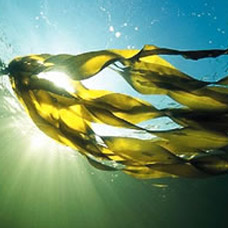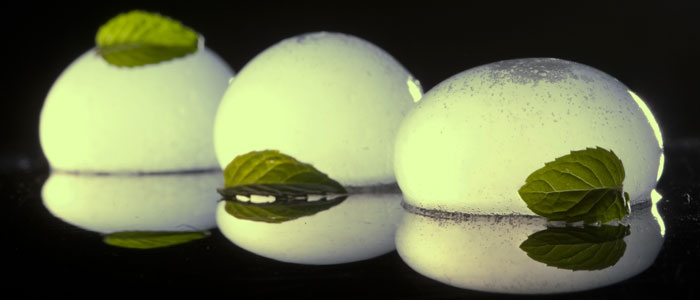Sodium Alginate (alginate, algin)
Sodium Alginate is a natural polysaccharide product extracted from brown seaweed that grows in cold water regions. It is soluble in cold and hot water with strong agitation and can thicken and bind. In presence of calcium, sodium alginate forms a gel without the need of heat. In modernist cuisine, sodium alginate is mostly used with calcium salts to produce small caviar-like and large spheres with liquid inside that burst in the mouth. Sodium Alginate is also used in the food industry to increase viscosity and as an emulsifier. It is also used in indigestion tablets and it has no discernible flavor.
Sodium Alginate Origin
 Sodium Alginate is a natural polysaccharide product extracted from the cell wall of brown seaweed that grows in cold water regions. The natural function of alginate is to give flexibility to the seaweed, so it is common to find higher contents of alginate in species found in troubled waters. Sodium alginate was first studied in 1881 by English chemist ECC Stanford.
Sodium Alginate is a natural polysaccharide product extracted from the cell wall of brown seaweed that grows in cold water regions. The natural function of alginate is to give flexibility to the seaweed, so it is common to find higher contents of alginate in species found in troubled waters. Sodium alginate was first studied in 1881 by English chemist ECC Stanford.
Sodium Alginate Function
Sodium alginate is used to gel in presence of calcium, as shear-thinning thickener in absence of calcium, to stabilize emulsions or foams and to form films. In modernist cuisine, sodium alginate is mostly used with calcium salts to produce small caviar-like and large spheres with liquid inside that burst in the mouth. There are two main processes to create spheres, basic spherification and reverse spherification.
Sodium Alginate Applications
The most common application of sodium alginate in molecular gastronomy is to create spheres using the spherification technique developed by Chef Ferran Adria at el Bulli restaurant in 2003. The resulting spheres have a thin membrane of gel and are filled with liquid.

In the food industry, sodium alginate is used as thickener in sauces, syrups and toppings for ice cream. By thickening pie fillings with sodium alginate, softening of the pastry by liquid from the filling is reduced. Water-in-oil emulsions such as mayonnaise and salad dressings thickened with sodium alginate are less likely to separate into their original oil and water.
A common use of sodium alginate in the food industry is to make the pimiento strips inside pitted olives. The strips are made with pimiento puree that is gelled in thin sheets using sodium alginate and then cut into strips.
Sodium alginate is also used as stabilizers in ice cream. The addition of sodium alginate reduces the formation of ice crystals during freezing, giving a smooth result.
Another use of sodium alginate is to form films of sodium or calcium alginate and fibres of calcium alginates.
View recipes with Sodium Alginate
Sodium Alginate Properties
Temperature (gels and melts): not affected by temperature. Gel is heat stable up to 150 °C (302 °F) but prolonged heat treatment at low or high PH may destabilize the gel.
Texture: Thermo irreversible rigid and brittle gel in the presence of calcium. The higher the concentration of alginate and calcium, the harder the gel produced.
Appearance: clear and transparent.
Flavor release: as most hard set gels, poor flavor release.
Mouthfeel: lingering and sticky.
Freeze / Thaw stable: yes, in most applications.
Syneresis (weeping): yes, increases with gel strength.
Shearing: breaks gel.
Interactions and Tolerance of Sodium Alginate
PH Tolerance: good, does not gel at PH below 3.7 so increase PH when using acidic ingredients such as lemon juice. Sodium Citrate is usually used to increase PH but it can increase saltiness if not used moderately. Acidity is an issue with basic spherification but not with reverse spherification. In reverse spherification a gel membrane forms around the edible liquid but the edible liquid itself does not gel.
Other Tolerances: up to 50% of ethanol but sodium alginate needs to be hydrated before adding alcohol
Inhibitors: PH < 3.7 For preparations below this PH, adjust it by adding sodium citrate but be aware that sodium citrate tastes salty and will alter the final flavor so use with moderation.
Ion Sensitive: yes, forms gel in presence of Calcium. For Basic Spherification you can use calcium chloride but with Reverse Spherification you should use Calcium Lactate or Calcium Lactate Gluconate (preferred) for optimal taste.
Synergies with other ingredients: Sodium alginate forms strong gel with high sugar concentration, weaker gels in presence of Agar or high concentrations of ions. When used for thickening, sodium alginate results in higher viscosity when used with locust bean gum or guar gum.
How to Use Sodium Alginate
Concentration Range: 0.5-1% for spherification. Up to 1.5% for other applications.
Hydration: cold or hot water
Dispersion: under shear using blender, do not use hard water or liquids with calcium content or acidic for dispersion. Dispersion can be improved by mixing with sugar or other powder ingredient before adding into liquid. Air bubbles usually get trapped in the solution. To eliminate the bubbles, let it rest in the fridge for a few hours or you can place it in a vacuum chamber.
Setting: high speed, cold setting.
Special Characteristics: N/A
Chemical Reaction
There are two methods of preparing an alginate gel. The one originally used by Chef Ferran Adria is the diffusion method in which the crosslinking calcium ion diffuses from an outer reservoir into an alginate solution (Basic Spherification). Gels form when a calcium salt is added to a solution of sodium alginate in water. The gel forms by chemical reaction, the calcium displaces the sodium from the alginate, holds the long alginate molecules together and a gel is the result. No heat is required and the gels do not melt when heated. This is in contrast to the agar gels where the water must be heated to about 80°C to dissolve the agar and the gel forms when cooled below about 40°C. The third property of alginates is the ability to form films of sodium or calcium alginate and fibres of calcium alginates.





 (14 votes, average: 3.36)
(14 votes, average: 3.36)
